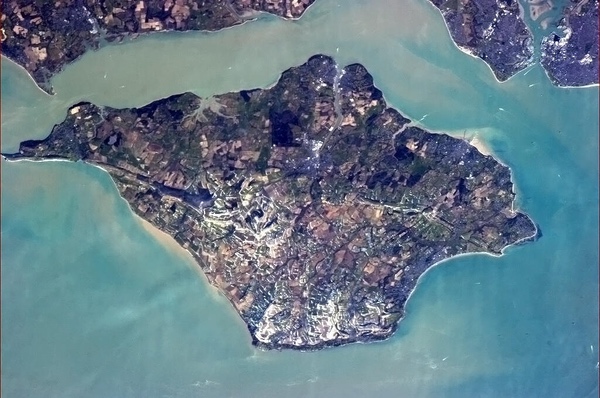Isle of Wight aerospace: flying boats, rocket interceptors, hovercraft, and launch vehicles (part 1)by Trevor Williams
|
| Unsurprisingly given its maritime heritage, Saunders-Roe focused up through World War II primarily on the development of flying boats and seaplanes. It then had several extremely varied projects. |
Despite these handicaps, many excellent aircraft designs were produced in Britain during the late 1940s and 1950s. One example was the English Electric Canberra, which first flew in 1949 and entered service with the Royal Air Force in 1951. It was subsequently built under license in the US (a rarity) by the Glenn L. Martin Company as the B-57, entering service with the USAF in 1954. Three of the WB-57 variants of this aircraft, with a ceiling of over 60,000 feet (18,000 meters), are still flying for NASA. Another outstanding aircraft was the Avro Vulcan strategic bomber, which first flew in 1952. This tailless delta wing aircraft was found to have a very small radar cross-section, having by coincidence been designed to be stealthy before that was even a known objective. The English Electric Lightning (first flight 1954) was an interceptor that could exceed Mach 2: it was designed to defend the airfields of the Vulcan bombers. Two other notable aircraft were the Hawker Hunter (first flight 1951), a transonic swept-wing jet fighter, and the Folland Gnat (first flight 1955), originally designed as a small, lightweight fighter, but which came into its own as a trainer.
 English Electric Canberra, Avro Vulcan and English Electric Lightning. (credits: RAF, Creative Commons and RAF Museum, resp.) |
Future military aircraft developments were severely curtailed because of the White Paper on future defense policy that was released by the government in April 1957.[2] This essentially stated that the day of piloted fighters and bombers was over: future warfare would be conducted solely using missiles. Several promising aircraft developments, some of which had already reached the prototype stage, were cancelled, and the Lightning barely survived: it was to be used to deter Soviet supersonic bombers until the British missile force was fully operational. In addition, the document forced the reorganization of the aerospace industry by dictating that the many existing companies should be merged to form a few larger ones: only these amalgamated firms would then be eligible to compete for new contracts. This led to the creation of the merged British Aircraft Corporation and Hawker Siddeley companies in 1960, and Westland Helicopters in 1961.
One smaller company that was strongly affected by the 1957 White Paper was Saunders-Roe, based in East Cowes on the Isle of Wight. This firm was formed in 1929 when aviation pioneer Alliott Verdon Roe bought a controlling interest in the S.E. Saunders shipbuilding and aircraft company.[3, p. 171] Unsurprisingly given its maritime heritage, Saunders-Roe focused up through World War II primarily on the development of flying boats and seaplanes. It then had several extremely varied projects, and finally served as the prime contractor for the Black Arrow orbital launch vehicle.
Saunders-Roe Princess flying boat: 1946–1954
Saunders-Roe’s flying boat work culminated in the SR.45 Princess flying boat, the design of which was started immediately after the war. The Princess was a massive vessel and is still the largest all-metal flying boat ever built: its length was 148 feet (45 meters), wingspan 220 feet (67 meters) and all-up weight 330,000 pounds (150,000 kilograms)[4, p. 28]. This size is broadly comparable to that of a Boeing 767, but a major distinction was that the Princess would have only carried 105 passengers, in a two-deck layout, since the thinking was that it would have to provide comparable luxury to that of an ocean liner. The Princess was powered by ten Bristol Proteus turboprop engines.
| The Princess seaplane nearly played a supporting role in the Apollo program. |
Development of this engine encountered many problems, which in turn delayed the development of the aircraft. It first flew on August 22, 1952, but by then the airline that had been the target customer, BOAC, had decided that the economics were not favorable. Consequently, although the first prototype Princess successfully flew 97 hours over 46 test flights up to May 27, 1954, and two other prototypes were largely completed, all three were put in storage: they were “cocooned” to prevent corrosion in the sea air, in the hope that future alternative applications would appear. At one point, the US Navy was reportedly [4, p. 52] interested in converting the Princess for use as a testbed for nuclear propulsion. In addition, Saunders-Roe submitted a proposal to the government in September 1957 [4, p. 52] to convert the Princess to a landplane version powered by six Rolls-Royce Tyne turboprops, but this did not proceed beyond studies.
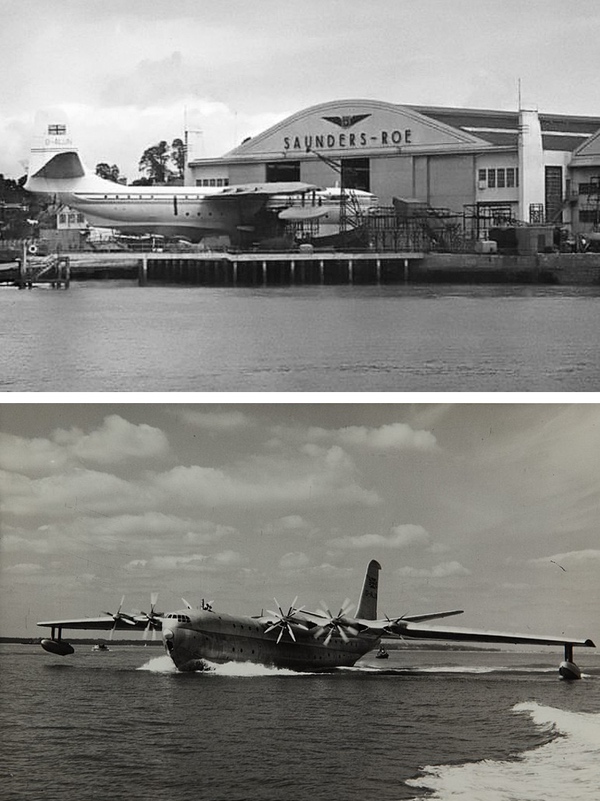 Princess outside Saunders-Roe Columbine hangar, East Cowes, and taxiing on the Solent. (credits: Ian Dunster and San Diego Air & Space Mus., resp.) |
A related application nearly led to the Princess playing a supporting role in the Apollo program. Aerospace Lines Inc. (ASI) operated the Pregnant Guppy [5], which entered service in May 1963: this was a greatly modified version of the Boeing 377 Stratocruiser airliner. The 377 fuselage had a “double-bubble” cross-section, with a smaller arc at the bottom (containing a passenger lounge and cargo section) connecting to a wider arc at the top (containing the main passenger deck). In the Pregnant Guppy, a larger arc replaced much of the original upper arc, giving a “triple-bubble” cross-section with a usable cargo diameter of 20 feet (6.1 meters). This allowed the aircraft to carry such outsized cargo for NASA as Gemini-Titan stages with a diameter of 10 feet (3 meters), F-1 engines, the Pegasus spacecraft, and the S-IV second stage of the Saturn I, which had a diameter of 18 feet (5.5 meters).
However, it was not able to carry the S-IVB (used as the third stage of the Saturn V and the second stage of the Saturn IB), which had a diameter of 21 feet 8 inches (6.6 meters). Consequently, Aero Spacelines developed the larger Super Guppy, with an internal diameter of 25 feet (7.6 meters), which entered service in December 1965 and was used to carry numerous payloads for NASA, including the S-IVB and the Apollo spacecraft.
However, this aircraft was still too small to carry either the S-IC first stage or S-II second stage of the Saturn V, both of which had a diameter of 33 feet (10.1 meters). The company therefore researched large aircraft that could potentially be stretched to achieve this diameter, and became interested in the Princess prototypes.[6, p. 314][7] Their concept appears to have been based on the possible landplane version, but expanded to give an interior with a height of 38 feet (11.6 meters) and a width of 37 feet (11.3 meters), and a payload mass of 200,000 pounds (91,000 kilograms)[7]: this would have allowed it to transport the S-II stage but not the S-IC. The figure below, from[5], is presumed to show this stretched Princess: note the characteristic dihedral of the tailplanes and the six turboprops. The price was estimated to be $15–18 million for one aircraft. All three Princesses were purchased on behalf of ASI by a third party,[8] and negotiations began[9] for Aero Spacelines to purchase at least two of them for its own use. Unfortunately though, it was found that the cocooning process had not sufficiently protected the airframes, and extensive corrosion had occurred. Consequently, the sale fell through and the Princess prototypes were instead broken up in 1967, bringing the era of large flying boats finally to an end.
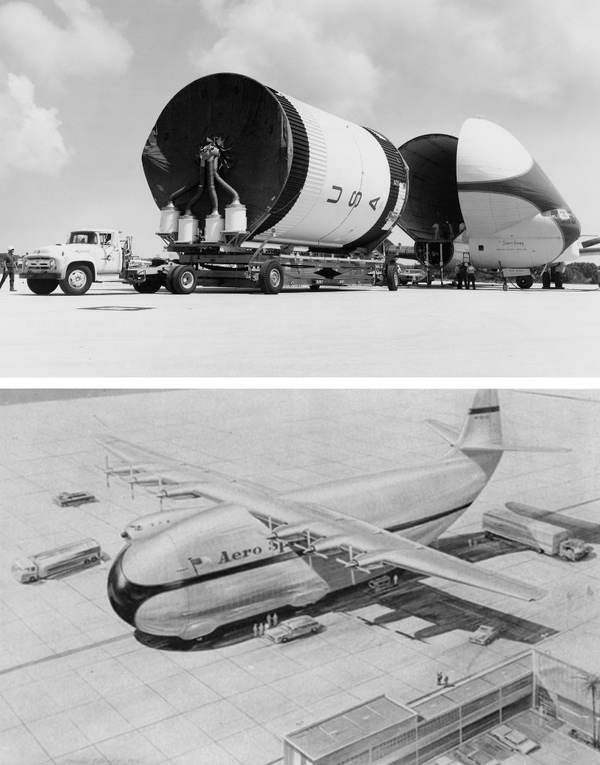 Super Guppy and S-IVB stage; possible stretched version of Princess for transport of S-II stage. (credits: NASA and AllAboutGuppys.com, resp.) |
Saunders-Roe jet/rocket-powered interceptors: 1952–1959
Overlapping with the test flying of the Princess was the start of development of a quite different type of aircraft, the SR.53: this was a supersonic interceptor powered by a combination of jet and rocket propulsion. Six companies competed for the contract to build this aircraft. Saunders-Roe eventually won it, even though the government had initially not invited them to propose, as it seemed far from the company’s usual flying boat projects. (Their experience developing and flying the SR.A/1 jet-powered seaplane fighter between 1947 and 1951 appears not to have been taken into account.) The SR.53 was designed to use a de Havilland Spectre rocket engine to propel it to an interception with enemy bombers at high speed (specifically, at up to Mach 2.2), analogous to the German Me 163 Komet in World War II. The Spectre had a maximum thrust of 8,000 pounds-force (35.6 kilonewtons), and was throttleable down to 10%. The onboard propellant allowed the rocket to burn at full thrust for only a handful of minutes; in order to avoid having to glide back to base, the SR.53 was also equipped with an Armstrong Siddeley Viper turbojet, of maximum thrust 2,700 pounds-force (12.0 kilonewtons). This aircraft had very impressive performance, which the two prototypes demonstrated over 56 flights totaling 17.5 hours between May 16, 1957, and October 20, 1959.
One reason why the SR.53 was preferred in the selection process was that, unlike its competitors, the Spectre rocket made use of the kerosene/high-test peroxide (HTP) propellant combination.[10, p. 61] This combination was quite prevalent in early British rocketry, and will be seen later to have been used for the Black Arrow launcher. A key advantage is that HTP is storable at room temperature, unlike the alternative liquid oxygen: this was felt to be a key advantage for application to an operational aircraft, for instance preventing the formation of ice on the aircraft. There is also less risk of fire with HTP: the Royal Navy was very concerned about the risk of oxygen-fed fires onboard an aircraft carrier.[10, p. 61] In addition, HTP decomposes in the presence of a catalyst into a high-temperature mixture of steam and oxygen that then spontaneously ignites with the kerosene, so no igniter is required. The downside of this simplicity is that kerosene/HTP has a specific impulse around 9% lower than that of kerosene/oxygen. Depending on the application, this tradeoff can be worth making.
| A the time it was developed, the SR.177 was an extremely impressive aircraft, and its cancellation was a significant missed opportunity for Saunders-Roe, and for British aerospace in general. |
Development of a follow-on aircraft, the SR.177, was also started in September 1955: this was larger than the SR.53 and, unlike it, had an onboard radar, avoiding the need to be vectored to the target from the ground. It was also equipped with a higher-performance turbojet, the de Havilland Gyron Junior, which improved the performance of the aircraft by allowing the initial climb to be carried out under jet power. The uprated Spectre rocket engine, with 10,000 pounds-force (44.5 kilonewtons) maximum thrust, was then only required for the high-speed sprint towards the target. Mockups of the SR.177 were constructed and the Royal Air Force, Royal Navy, and German Defense Ministry all expressed considerable interest in it.[6, pp. 63, 66] However, the 1957 White Paper that advocated the use of missiles rather than piloted aircraft brought British government support for this project to an end, which then also led to the withdrawal of German interest.
Combined turbojet and rocket propulsion would not be as attractive these days, as similar performance could be obtained using a turbojet alone if equipped with a modern afterburner. However, at the time it was developed, the SR.177 was an extremely impressive aircraft, and its cancellation was a significant missed opportunity for Saunders-Roe, and for British aerospace in general.
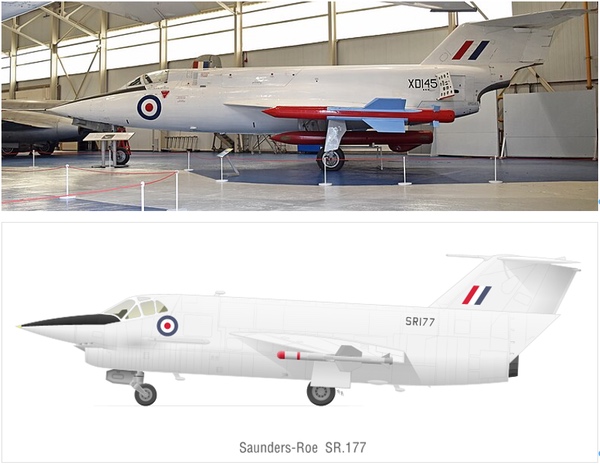 SR.53 and SR.177 jet/rocket interceptors. (credits: Alan Wilson and Emoscopes, resp.) |
Saunders-Roe hovercraft: 1957–1966 (then as British Hovercraft Corporation)
One additional project produced by Saunders-Roe was the hovercraft. This came from the work of the inventor Christopher Cockerell,[11] which he first demonstrated by means of an experiment involving two nested tin cans connected to a blower. In 1953 he then built and tested a small-scale model hovercraft, 2.5 feet (0.76 meters) long and weighing 5 pounds (2.3 kilograms), which gave encouraging results. The involvement of Saunders-Roe began when they received an eight-month classified contract in August 1957 to check out Cockerell’s results; the cancellation of the SR.177 meant that the company had a team of engineers available for this work. Their testing did indeed confirm Cockerell’s conclusions.
At this point no military applications had been identified for the hovercraft, so Saunders-Roe submitted a proposal to the National Research Development Corporation (NRDC) in September 1958 to investigate its uses for civil applications. This led to the construction of the first hovercraft, the SR.N1 (Saunders-Roe Nautical 1): this was 30.3 feet (9.2 meters) long, 17.2 feet (5.2 meters) wide, weighed 6,600 pounds (3,000 kilogra,s), had a cruising speed of about 20 knots (10 meters per second) and carried a crew of two. Its first untethered hover took place on June 7, 1959, and it was presented to the press in East Cowes on June 11. SR.N1 then crossed the English Channel on July 25, 1959, with its regular crew and Cockerell onboard as an observer: this was the 50th anniversary of Louis Bleriot’s first crossing of the Channel by airplane. SR.N1 was then operated for four years and made valuable contributions to hovercraft design, for instance showing the improvement in performance produced by using a skirt to retain the air under the vehicle.
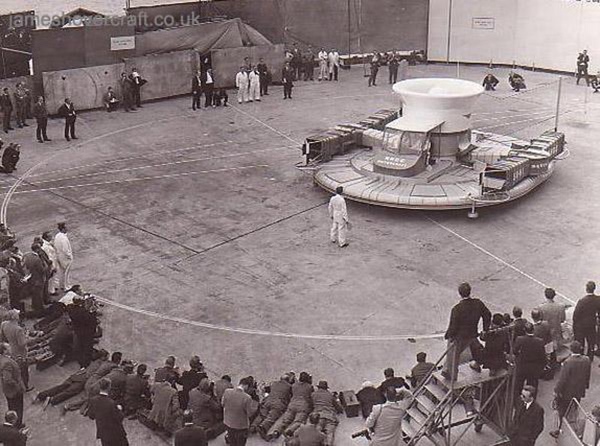 First hovercraft, SR.N1, 1959. (credit: James’ hovercraft website.) |
Hovercraft development at Saunders-Roe culminated in the SR.N4 Mountbatten class vehicles (Lord Louis Mountbatten was an early hovercraft supporter). These large hovercraft, 184 feet (56.1 meters) long by 78 feet (23.8 meters) wide and with a gross weight of 319 tons (290,000 kilograms), were in cross-Channel service between 1968 and 2000. The stretched Mk. 3 version, examples of which were The Princess Margaret and The Princess Anne, could carry 418 passengers and 60 cars at speeds of 40–60 knots (21–31 meters per second). This was much faster than the competing car ferries, but ferries could carry far more cars. In the end the hovercraft could not compete with them, and both struggled against the Eurotunnel, which opened in 1994.
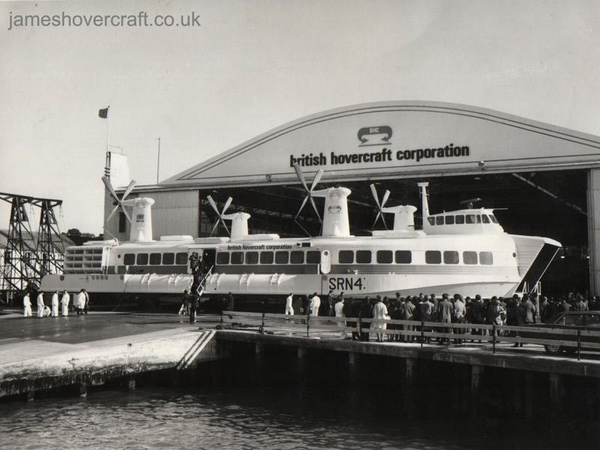 SR.N4 Mountbatten class hovercraft, 1967. (credit: James’ hovercraft website.) |
The hovercraft was initially so novel a concept that it was not even clear what to call it: an article in Aviation Week & Space Technology in April 1959 [12] referred to the SR.N1 as a “ducted fan vehicle”, while in Profiles of the Future [13, p. 55], originally published in 1962, Arthur C. Clarke called hovercraft Ground Effect Machines (GEMs). Clarke is, for good reason, famed for his predictions, including of the geosynchronous communication satellite. On the subject of hovercraft, however, he wrote [13, p. 58]:
Today’s turnpikes might well last for generations without any further maintenance, if they had to carry only air-supported vehicles; the concrete could crack and become covered with moss – it would not matter in the least. There will clearly be enormous savings in road costs – amounting to billions a year – once we have abolished the wheel. But there will be a very difficult transition period before the characteristic road sign of the 1990s becomes universal: NO WHEELED VEHICLES ALLOWED ON THIS HIGHWAY ...
This fits with what Yogi Berra is supposed to have said: “It’s tough to make predictions, especially about the future”. But Clarke was not alone in expecting the hovercraft to revolutionize travel. Several factors prevented this: one was the high noise they generated, and another the challenges of controlling them. Piloting one is more reminiscent of flying a plane than of driving a car, for instance requiring crabbing into crosswinds; in addition, traveling on slopes presents special challenges. Training to operate a hovercraft would therefore be much more difficult than passing a driving test. Today, the sole remaining year-round scheduled passenger hovercraft service in the world is that between Southsea on the English south coast and Ryde on the Isle of Wight. This seems somehow fitting.
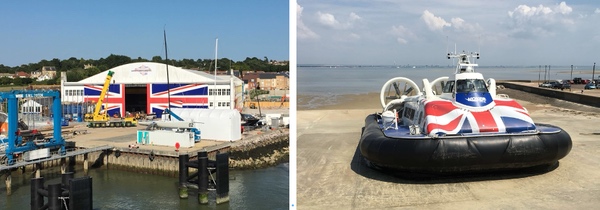 Present day Isle of Wight: Columbine hangar, East Cowes, 2019; Southsea-Ryde hovercraft ferry, 2018. (Credits: author.) |
Following this disappointment, the snakebit Saunders-Roe ceased to exist as an independent company: part merged with Westland Aircraft, and part became the British Hovercraft Corporation before finally also merging with Westland, which was in turn itself taken over by GKN in 1994. However, before its demise, Saunders-Roe had one last major part to play, this time in the development of British missiles and orbital launch vehicles. That is the subject of Part 2 of this article.
References
- Made on the Isle of Wight, D.L. Williams, The History Press, 2016.
- Defence: Outline of Future Policy, Command Paper 124, Secretary of State for Defence, Her Majesty’s Stationery Office, London, April 1957.
- British Built Aircraft, Volume 2: South West & Central Southern England, R. Smith, The History Press, 2003.
- The Saunders-Roe Princess Flying Boat Project, B. Worthy, Solent Aeromarine Enterprises, 2003.
- All About Guppys
- Stages to Saturn: A Technological History of the Apollo/Saturn Launch Vehicles, R.E. Bilstein, The NASA History Series, SP-4206, 1980.
- “Aero Spacelines Seeks Princess Flying Boat”, Aviation Week & Space Technology, Nov. 18, 1963, p. 31.
- “U.K. Government Sells Princess Flying Boats”, Aviation Week & Space Technology, Jan. 13, 1964, p. 38.
- “Aero Spacelines Seeking Options to buy Saunders-Roe Flying Boats”, Aviation Week & Space Technology, Jan. 20, 1964, p. 34.
- Project Cancelled: British Aircraft that Never Flew, D. Wood, Bobbs-Merrill, 1975.
- On a Cushion of Air: The Story of Hoverlloyd and the Cross-Channel Hovercraft, R. Paine and R. Syms, Kindle, 2012.
- “Saunders-Roe Studies Ducted Fan Vehicle”, Aviation Week & Space Technology, Apr. 27, 1959, pp. 32-33.
- Profiles of the Future, A.C. Clarke, Pan Books Ltd., 1973 (revised).
Note: we are now moderating comments. There will be a delay in posting comments and no guarantee that all submitted comments will be posted.
